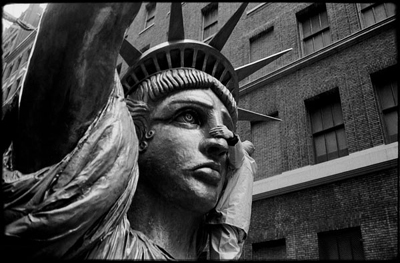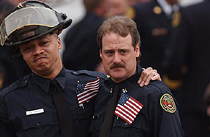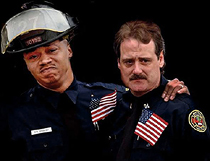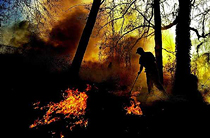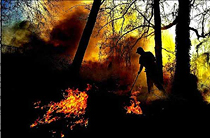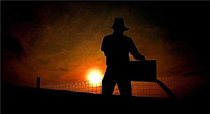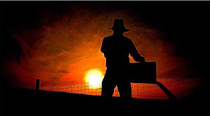In defense of photographer
Patrick Schneider
and the fictions of a "Code of Ethics"
***
In Search of Liberty © Pedro Meyer 1986 |
|
|
Last week, the North Carolina Press Photographers Association in the United States, rescinded three Pictures of the Year awards given to Charlotte Observer photographer Patrick Schneider. We find the behavior of many of the photojournalists whose names appear below who have passed very ill advised judgment on Mr Schneider, as well as many of the picture editors in their corresponding newspapers who share their views, to have reached such an incredible low point in this ongoing debate about the veracity of images in photojournalism. We might be reaching the dark ages again. But more about that later. The NCPPA board voted 4-0, with one abstention, to strip Schneider's awards after determining that he had removed background information from certain images through excessive adjustments in Photoshop. Board members include NCPPA president and News & Observer (Raleigh, N.C.) photographer Chuck Liddy, Ted Richardson and Jennifer Rotenizer, photographers at the Winston-Salem Journal, and Chris English, a photographer at UNC Greensborough. David Foster, a photographer at The Observer, abstained. Liddy told The Observer that Schneider had violated the Code of Ethics outlined by the National Press Photographers Association (NPPA), which states in part: "In documentary photojournalism, it is wrong to alter the content of a photograph in any way (electronically, or in the darkroom) that deceives the public." Questions first arose about Schneider's work after two photographers came to him with complaints. Liddy says the photographers, whom he won't name, threatened to go to the NPPA if action wasn't taken at a state level. Mr. Liddy, rather than taking the bull by the horns, and denounce the perpetrators of such accusations that can only send photography several decades back, allied himself with the thinking of these narrow minds, setting himself and the entire crew at the NCPPA for a fall. But we shall see further on why we believe that they are so utterly wrong in their judgments. The NCPPA then took their concerns to The Observer, which performed an audit of the photographer's work. After looking at thousands of images, Observer editors say they found only a handful that were objectionable. Editor Jennie Buckner concluded that Schneider did not intend to deceive readers or contest judges, but that "he went over the line in the use of some techniques, which altered the backgrounds in ways that left us uncomfortable." After nearly a month of negotiations, The Observer released Schneider's raw files to Liddy and the NCPPA. Schneider, who has won several NCPPA awards over the last few years, declined to comment on specific images, but Liddy says background details such as parking lots, fences and people were taken out of the pictures by using the digital equivalent of "hand of God" burns. Speaking about one sunrise photo (pictured), Liddy says Schneider's digital color enhancement resulted in what was "basically a made-up picture". So let us review some of the accusations leveled at Mr. Schneider about the integrity of his images. Also in the context of the Brian Walski photographs in the Los Angeles Times, that led to his dismissal for compositing two images from Iraq (see the debate generated in ZoneZero's forums on this matter). First of all, we have to place all of this into a larger context, otherwise we end up looking solely at the "burning or dodging tool" as if that would somehow represent the overarching depth of the argument. If we are to delve into the issue of integrity I am sure that many of those newspapers that are so decidedly against their photographers using the tools of their trade as they see fit, have a lot to answer about many other issues that we might as well bring up at this time so that we can take a better look at the entire panorama of what is going on here. EMBEDDED PHOTOJOURNALIST. For instance, what went on across the communications industry with their arrangements with the US Military and their "embedded photojournalists" with the recent war on Irak, and how that turned out as far as all the distortions of information and manipulation of truths. These dispositions in essence compromised all of the photojournalists involved, as they inevitably became a propaganda machine not an agency for information. So one would have to ask oneself what were they all thinking of, when discussing this so called "code of ethics" about some one using a lighter shades of colors in their images through image manipulation, and attributing to that a distortion of content, while at the same time they covered up for the use of embedded photojournalism. I suppose one can look at this with some degree of humor, if it were not as serious. Sure it is far easier to use Mr. Schneider or Walski, as scapegoats for having used their skills to make a better image without distorting the essential information in their corresponding images, rather than to address the fundamental flaws in the information they are providing to the world at large. The newspaper and magazine organizations are diverting the attention to the photographers modus operandi, as if that was the cause for any loss of credibility, and hoping to regain it, by chastising creativity and the use of the tools of the 21st century, rather than taking a good look at the real causes behind any loss of trust by the public. They have conveniently forgot that THEY HAVE BEEN LYING using so called STRAIGHT IMAGES, ALL ALONG! What were these very same publications telling the world about the war on Iraq, before the bombing started? Were they casting the same critical judgment on their written assertions about the "weapons of mass destruction" statements, as they do now on dodging and burning technique applied to a photograph? When the photographer became an embedded photographer, any sense of "objectivity" had to have become totally lost, so who was then the guardian for integrity at those news organizations at the time? Who got fired for accepting such arrangements? Does anyone have any doubt that the photographs had only a little to do with the overall "truth" of what was going to happen in Iraq? Apparently six moths after the invasion of Iraq, the US public has now had to discover that their "heroic welcoming" imagery were mostly photo-ops set up by the military establishment. Have all those photographers who took those historically altered images, been fired? I think not. Mind you, the propaganda machine worked, for a time, mostly for internal US consumption, not outside of the US. The rest of the world was getting regularly better information, and still is. I would have assumed that all photographers would stand up for their rights to use their tools as they saw fit, leaving the issue of integrity and veracity of the image to their individual responsibility. Any photographer who needs to be explained what misleading information is or looks like, should not be given a camera in the first place. You don't need a computer to create a misleading image as we all know, so one would need to have a clarity about such issues and how to deal with them the moment the images are taken. The statue of Sadam Hussein being torn down in Baghdad (see the debate generated in ZoneZero on this matter) is one very good example of straight pictures which were totally manipulated without the need for any computer. However, let us look at what the pictures that were denounced to and by the NCPPA as being in violating the "code of ethics" which allegedly deceived the public. ALTERING THE BACKGROUND First: None of the three images which they dismissed from the awards, in our opinion, had the slightest possibility of being misinterpreted as to their content, by anyone. Between what the photographer had originally captured and what he delivered, the interpretations were absolutely identical as to the content, what changed was an esthetical value, and we agree with the photographer, for the benefit of the images. The changes introduced by Mr. Patrick Schneider did not alter the fundamental information in the photographs. Second: The variations denounced as transformation of Mr. Schneider's images are so frivolous that one could account for such shifts alone by the changes in printing quality from one publication to another. So were do they go from here? Third: The panel, had a serious lapse of judgment, misunderstanding aesthetically pleasing traits within an image for content misinformation. I suppose that they will in the end advocate for all written journalist to get rid of spelling checkers as that might also lead to the distortion of information received should anything be corrected. And possibly our latter day Savonarolas' will find it appropriate to demand those who tape an interview will now have to publish it verbatim, as who knows, no one can risk that the public not trust journalists. So, no more of this editing stuff. In conclusion, I would say, that who we have to hold to the coals are many of the newspaper organizations and associations that support so many of the false arguments and misguided codes of ethics, not the photographers. It is time to get our act together and start to respond to these utter unreasonable demands, which only put confusion the issues. Clearly, photojournalists of integrity must accept that they have a responsibility to be truthful in the information they provide, but that is no more or less than what is expected of any journalist, whether they are photographers or writers. NEW CODE OF ETHICS Stop telling us how an image is supposed to be created. Stop telling us what constitutes the "right color" when in fact you could be color-blind and the images when printed offer variations that surpass the arguments you are presenting against alterations. Stop telling us how our images are supposed to be produced when you place any caption that suits your needs or crop the pictures as you see it fits. Stop telling us about the truth in pictures when you constantly use those very same pictures out of context to satisfy your editorial needs to support texts or headers that have arbitrarily been pulled together. Stop telling us about the truth in photojournalism when what you are selling most times is propaganda disguised as information. In short, stop manipulating photographers and photography to cover up for what constitutes an industry with a wide and very shameful performance. I truly believe that the photographers should be considered fully responsible for their results, yes you need to define what that means, but not by telling us what not to use, as if we were seven year old kids, but what the goals are: Veracity in the story being told. As my friend Chip Simone wrote: -the "electrojournalists" of today, have a totally new set of opportunities and thus responsibilities-. The definition of a responsibility can not established by setting a constraint on the tools to be used, that seems to be utterly lacking in imagination. THE PHOTOGRAPHER The importance in the gesture of the two firemen in the picture below is what that image seems to be all about, not the background. For any judges to have made an issue about the background and disqualifying the image as an alteration is unacceptable, is not to have understood the nature of image making and the significance of what Patrick Schneider actually did. He not only saw when he took the image, but he continued seeing afterwards, something that seems to have completely eluded the NCPPA people in their utter confusion of what the new tools of this century bring to photography. In our estimation, Mr. Schneider used the computer in order to enhance and make a better picture, he performed this to the best of his abilities and he certainly did not misrepresent anyone. The only ones who in fact misrepresented everything were those who actually pointed at him with their accusing fingers. Pedro
Meyer pictures by Patrick Schneider Click over the images to enlarge them. RELATED LINKS:
Please share your comments on this issue with us in our forums.
|
|
